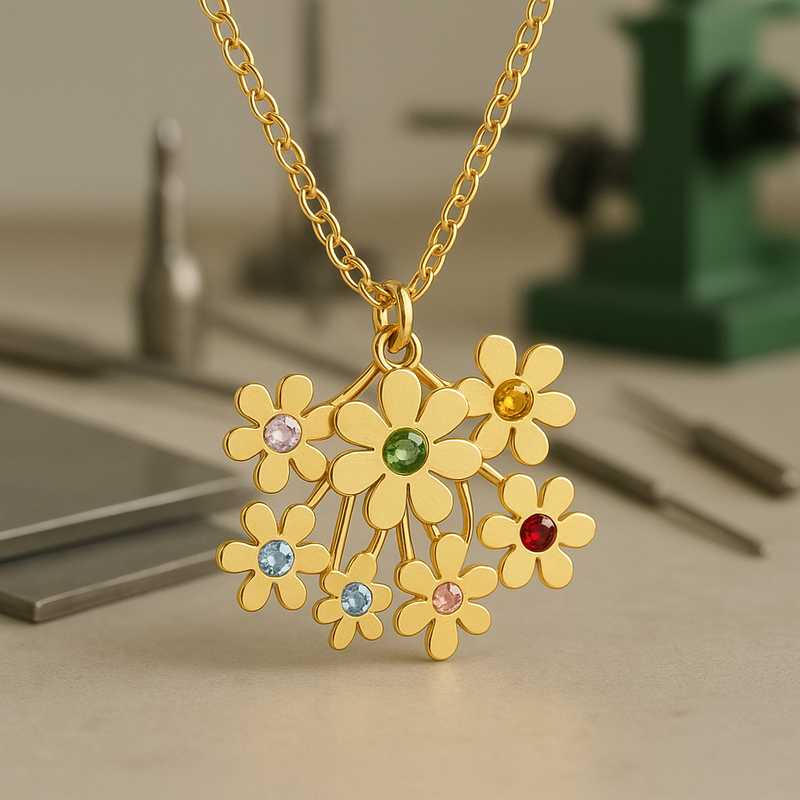Engineering Elegance: The Tech Behind Custom Gold Charm Necklaces

Introduction: Bridging Beauty and Engineering in Jewelry Manufacturing
Behind every elegant custom gold charm necklace lies a story of engineering precision, material science, and sustainable innovation. As B2B clients increasingly seek unique, customizable options like birth month flower and birthstone charm bouquets, the need for high-performance, eco-conscious manufacturing has never been more critical. From choosing the right stainless steel alloy to leveraging cutting-edge fabrication techniques and minimizing environmental impact, today’s OEM/ODM jewelry manufacturers are transforming artistry into a science. This page explores how advanced materials and green technologies combine to produce not only beautiful but also resilient and sustainable charm necklaces tailored for modern wholesale clients.
Material Science Spotlight: 304 vs. 316L Stainless Steel
One of the foundational decisions in crafting custom stainless steel jewelry lies in selecting the optimal grade of stainless steel. While both 304 and 316L stainless steels are corrosion-resistant and aesthetically adaptable, their properties lend themselves to different use cases in jewelry production.
304 Stainless Steel: Known for its high tensile strength and affordability, 304 is a popular choice for mass-market jewelry. It contains 18% chromium and 8% nickel, providing a balance of corrosion resistance and formability. However, it is less resistant to chlorides, making it less ideal for jewelry worn during high-sweat activities or in marine environments.
316L Stainless Steel: Also known as surgical-grade stainless steel, 316L contains 2-3% molybdenum, enhancing its resistance to chlorides and harsh chemicals. Its hypoallergenic properties and higher durability make it the preferred choice for premium custom charm necklaces that are worn daily or given as heirloom gifts. This is especially vital for charm bouquets with delicate laser-cut floral motifs and embedded birthstones, where longevity is key.
Case Insight: A European distributor specializing in personalized birthstone charms reported a 40% reduction in returns and a 25% increase in customer satisfaction after transitioning from 304 to 316L in their product lines aimed at the luxury gifting market.
Precision Techniques: Laser Cutting, Hydraulic Stamping, and Corrosion Patterning
Creating detailed, scalable designs such as intricate flower charms or gemstone settings requires more than traditional craftsmanship. Modern B2B manufacturers employ a suite of precision technologies that enhance both quality and repeatability.
- Laser Cutting: Ultrafine laser beams allow for micro-cutting of floral silhouettes, resulting in clean edges and intricate petal detailing on charms as small as 5mm. The process eliminates burrs and reduces material waste.
- Hydraulic Stamping: For volume production, hydraulic presses ensure uniform thickness and consistent shaping, particularly useful for three-dimensional bouquet components. Tooling can be customized for OEM clients to accommodate logo engraving or proprietary floral designs.
- Corrosion Patterning: A lesser-known technique involves selectively oxidizing stainless steel surfaces using acid etching or electrochemical processes. This creates contrast and texture without adding foreign materials, enhancing both aesthetics and anti-counterfeiting measures.
Example: A U.S.-based retailer used laser engraving combined with corrosion patterning to create limited-edition zodiac flower charms, allowing them to charge a 20% premium for visual uniqueness without increasing production cost significantly.
Green Manufacturing: Eco-Conscious Innovations in Jewelry Production
In today’s B2B market, sustainability is more than a buzzword—it’s a competitive differentiator. Green manufacturing processes in custom charm necklace production ensure that environmental considerations are integrated from start to finish.
1. Waste Recycling Systems
Modern stainless steel jewelry workshops are increasingly adopting closed-loop recycling systems that recover metal shavings, dust, and water used during production. This minimizes material waste and reduces operational costs, appealing to eco-conscious wholesale buyers.
2. Green Electroplating Technology
Traditional gold electroplating often relies on cyanide-based solutions, which pose risks to both workers and the environment. In contrast, green plating uses water-based, cyanide-free alternatives that comply with RoHS and REACH standards. These provide equally brilliant finishes and are especially important when creating birthstone-accented gold charms meant for sensitive skin.
3. Energy-Efficient Machinery
Laser cutters and polishers with energy recovery systems can reduce power consumption by up to 30%. Many manufacturers now pair these with renewable energy sources such as solar panels, lowering their carbon footprint and enabling B2B partners to market their jewelry lines as sustainable by design.
Case Study: A Japanese OEM supplier reduced their water usage by 45% after implementing a water recycling unit in their hydraulic stamping line—highlighted in client marketing as part of a “Green Luxe” initiative.
Customization Ecosystem: From OEM Vision to Finished Charm Bouquet
Creating a custom charm bouquet necklace involves more than selecting a flower or birthstone. Leading manufacturers provide an end-to-end ecosystem tailored for B2B partners, facilitating everything from initial concept development to post-production support.
- 3D Prototyping: Rapid prototyping tools enable clients to visualize and approve charm layouts before tooling begins, accelerating time to market.
- Modular Molds: Customizable mold inserts allow for seasonal or regional variations—like cherry blossoms for Japan or marigolds for Mexico—without full retooling.
- Secure Fulfillment: Integration with B2B logistics platforms ensures on-time global delivery, with options for bulk packaging or direct-to-retail white labeling.
Insight: One Scandinavian jewelry house was able to launch an entire year-round collection with interchangeable flower charms by partnering with a manufacturer offering modular mold customization. The adaptability significantly reduced SKU complexity while maximizing consumer appeal.
Conclusion: Partnering for Innovation in Jewelry Manufacturing
In a landscape where aesthetic distinction, durability, and sustainability are paramount, the engineering behind custom gold charm necklaces is what truly sets brands apart. By choosing advanced materials like 316L stainless steel, precision methods such as laser cutting and corrosion patterning, and eco-conscious technologies including green electroplating and waste recycling, OEM/ODM partners can deliver products that align with modern values and market demands.
Ready to turn your jewelry vision into engineered reality? Partner with a manufacturer who understands the intersection of elegance and innovation. Contact us today to explore custom solutions that resonate with your brand and your customers.
